The Wine Filling Machine Market is estimated to be valued at USD 1.5 billion in 2025 and is projected to reach USD 2.2 billion by 2035, registering a compound annual growth rate (CAGR) of 3.8% over the forecast period.
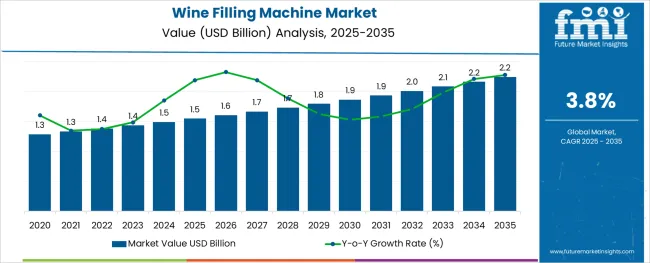
The wine filling machine market is experiencing notable growth as wineries increasingly focus on operational efficiency, product consistency, and compliance with hygiene standards. The shift toward automation and precision-driven equipment is driving demand across both premium and mass-market wine producers.
Manufacturers are responding to heightened expectations around quality control and production throughput by offering machines that minimize wastage and optimize resource utilization. Future growth is expected to be influenced by advancements in filling technologies, rising investments in modernization of bottling lines, and growing adoption of sustainable practices in production facilities.
The emphasis on enhancing productivity while maintaining product integrity is paving the way for further adoption, with increasing attention being given to customizable solutions and integration of intelligent monitoring systems.
The market is segmented by Mode of Operation, Application, Type, End-use, and Distribution Channel and region. By Mode of Operation, the market is divided into Fully automatic and Semi-automatic. In terms of Application, the market is classified into Red wine, White wine, and Sparkling wine. Based on Type, the market is segmented into Rotary filling machines and Linear filling machines. By End-use, the market is divided into Wineries, Breweries, and Distilleries. By Distribution Channel, the market is segmented into Offline and Online. Regionally, the market is classified into North America, Latin America, Western Europe, Eastern Europe, Balkan & Baltic Countries, Russia & Belarus, Central Asia, East Asia, South Asia & Pacific, and the Middle East & Africa.
The market is segmented by Mode of Operation, Application, Type, End-use, and Distribution Channel and region. By Mode of Operation, the market is divided into Fully automatic and Semi-automatic. In terms of Application, the market is classified into Red wine, White wine, and Sparkling wine. Based on Type, the market is segmented into Rotary filling machines and Linear filling machines. By End-use, the market is divided into Wineries, Breweries, and Distilleries. By Distribution Channel, the market is segmented into Offline and Online. Regionally, the market is classified into North America, Latin America, Western Europe, Eastern Europe, Balkan & Baltic Countries, Russia & Belarus, Central Asia, East Asia, South Asia & Pacific, and the Middle East & Africa.
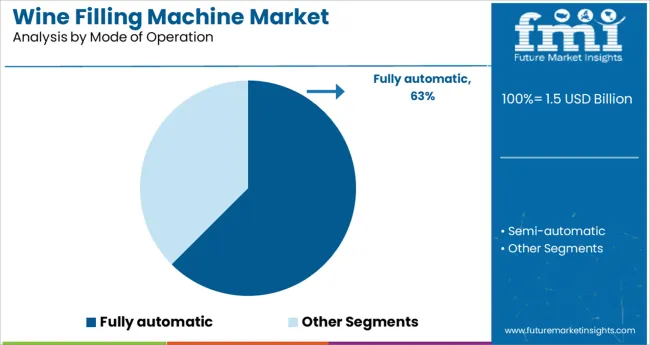
When segmented by mode of operation the fully automatic segment is anticipated to account for 62.5% of the total market revenue in 2025 maintaining its position as the leading segment. This leadership is attributed to the superior efficiency and precision offered by fully automatic systems which have allowed producers to scale operations while reducing human error and labor costs.
Observations indicate that these machines facilitate continuous high-speed production which is essential to meet the rising global demand for wine. Enhanced features such as automated cleaning cycles advanced sensors and seamless integration with upstream and downstream equipment have further strengthened their appeal.
The ability of fully automatic systems to ensure consistent fill levels and minimize wastage while adhering to stringent hygiene standards has reinforced their adoption among producers aiming to optimize productivity and regulatory compliance.
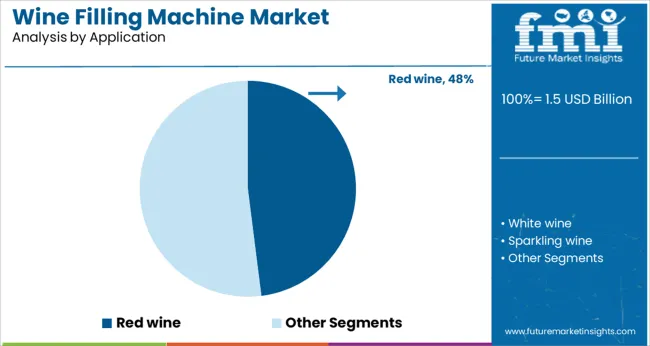
When segmented by application the red wine segment is projected to hold 48.0% of the market revenue in 2025 securing its place as the leading application. This prominence is driven by the significant global consumption of red wine and the need for specialized equipment that handles its particular characteristics with care.
The demand for machines capable of filling red wine efficiently without compromising on flavor integrity or exposing the liquid to excessive oxidation has reinforced this segment’s leadership. Enhanced features such as inert gas purging temperature control and gentle filling mechanisms have proven critical in addressing the quality expectations of red wine producers.
The consistent popularity of red wine across key markets combined with premiumization trends in the segment has contributed to sustained investment in dedicated filling solutions supporting its continued growth.
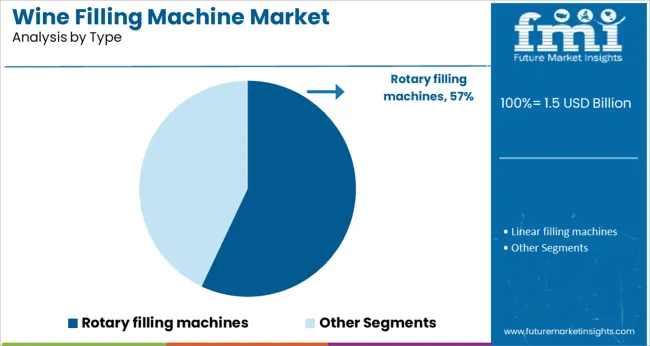
Segmenting by type shows that rotary filling machines are expected to capture 57.0% of the total market revenue in 2025 positioning themselves as the dominant type. This dominance stems from the ability of rotary machines to deliver high-speed continuous operation which meets the volume and efficiency demands of modern wineries.
Their compact design and capability to handle multiple bottle sizes and formats within the same line have further reinforced their adoption. Observations highlight that rotary machines offer superior output rates while maintaining accuracy and minimizing product spillage enhancing return on investment for producers.
The ease of integration into automated bottling lines coupled with reduced maintenance requirements and consistent performance under heavy-duty conditions has ensured the rotary filling machines remain the preferred choice for large and mid-sized production facilities.
According to Future Market Insights, the wine filling machine market was growing at a CAGR of 4.2% to reach USD 1,379.8 million in 2025 from USD 1,170.4 million in 2020.
The wine filling machine market is expected to grow significantly in the next few years. Historical data shows that the market has been growing at a steady pace over the last few years. However, future forecasts suggest that the market will grow at a much faster pace in the next few years.
The main reason for this growth is the increasing demand for wine globally. The world’s population is expected to continue to grow, and as incomes rise, more people are likely to consume wine. In addition, the global economy is expected to continue to grow, which will also lead to increased demand for wine.
Another reason for the expected growth in the wine filling machine market is the increasing popularity of premium and luxury wines. As consumer tastes change, more people are willing to pay higher prices for better-quality wines.
According to research by Future Market Insights, The Wine filling machine market is anticipated to expand at a CAGR of 3.8% during the forecasted period.
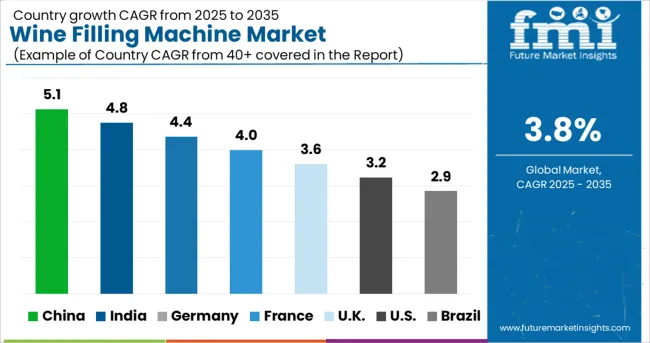
North America has had a dominant market share in the wine filling machine market for several years. There are a number of factors that have contributed to this. One is the fact that there are many large wine producers in North America, and they have been willing to invest in the latest technologies. This has led to a number of companies developing innovative wine filling machines that have been adopted by producers in other parts of the world.
Another factor that has helped North America maintain its dominance in the wine filling machine market is the fact that there are stringent regulations in place regarding the quality of wines produced. This has led to a need for machines that can fill bottles with wine quickly and accurately, without any spillage or wastage. North American manufacturers have been able to meet this demand, and their products are now being used by producers in other regions.
Europe has a high demand for wine, which creates a market for wine-filling machines. There are many factors that make Europe a desirable market for wine fill. The first factor is the climate. The climate in Europe is ideal for grape production, which is necessary for making wine. The second factor is the soil. The soil in Europe is rich in nutrients, which helps the grapevines to flourish. Finally, the third factor is history. The history of Europe is full of traditions and celebrations that involve wine. All of these factors combine to create a market that is ideal for companies that produce wine-filling machines.
The wine filling machines market is expected to grow significantly in the coming years due to the increasing demand for wine in Asia Pacific. The region is emerging as a major wine-producing and consuming region, with China, Australia, and India being the major players. The Asia Pacific wine industry is growing at a rapid pace and is expected to continue doing so in the coming years. This growth is driven by the increasing disposable incomes of consumers, the changing lifestyles of people, and the increasing number of women drinkers in the region. All these factors are contributing to the growth of the Asia Pacific wine filling machines market.
The food and beverage industry has a significant role in the growth of the wine filling machine market. The industry is responsible for the production of wine and other alcoholic beverages. In addition, the industry provides services such as packaging, marketing, and distribution of these products.
The food and beverage industry is a major contributor to the economy. It is estimated that the industry employs millions of people worldwide. The industry also generates billions of dollars in revenue each year.
The food and beverage industry plays a vital role in the growth of the wine filling machine market. The industry provides the necessary products and services to meet the demand for these machines. In addition, the industry creates jobs and generates revenue for the economy.
The growth of the wine filling machines market is primarily driven by the increasing demand for wine globally. The rising popularity of bottled wine and the growing preference for premium wines are some of the major factors driving the market for wine filling machines. In addition, the increasing focus on energy-efficient and eco-friendly packaging solutions is another major factor expected to boost the growth of this market over the forecast period.
The automatic wine filling machines segment is expected to witness significant growth over the forecast period due to their high accuracy and efficiency.
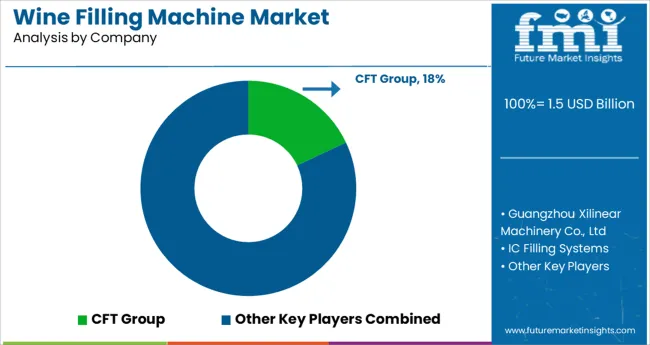
The competitive landscape of the wine filling machines market is expected to remain fairly consolidated in the coming years, with the top five manufacturers accounting for a significant share of the global market. The leading companies in the market are focusing on expanding their product portfolio and geographical reach to gain a competitive edge.
The wine filling machines market is highly fragmented with a large number of small and medium-sized manufacturers. The key players in the market are focusing on strategies such as mergers & acquisitions, product innovation, and expansion to stay ahead of the competition.
| Attributes | Details |
|---|---|
| Forecast period | 2025 to 2035 |
| Historical data available for | 2020 to 2025 |
| Market analysis | million in value |
| Key regions covered | North America; Eastern Europe; Western Europe; Japan; South America; Asian Pacific; Middle east and Africa |
| Key countries covered | The USA, Germany, France, Italy, Canada, The United Kingdom, Spain, China, India, Australia |
| Key segments covered | End-use, Type, Mode of operation, Application, Distribution channel, Region |
| Key companies profiled | CFT Group; Guangzhou Xilinear Machinery Co.; IC Filling Systems; JBT Corporation; Foshan Land Packaging Machinery Co., Ltd; Terlet; Sky Machine; Blenzor; Willman Machinery; APACKS; Topper Bottling Filling Machine; Multipack; E-PAK Machinery; Chenyu Machinery; Comac; King Machine; Filling Equipment Company; Luye Machinery; Leibinger GmbH; WELL Machinery; LONGER Machinery; Rejves Machinery; Shemesh Automation; Neostarpack |
| Report Coverage | Market Forecast, Company Share Analysis, DROT Analysis, Market Dynamics, Competitive Landscape, Challenges, Strategic Growth Initiatives |
| Customization and Pricing | Available upon request |
The global wine filling machine market is estimated to be valued at USD 1.5 billion in 2025.
It is projected to reach USD 2.2 billion by 2035.
The market is expected to grow at a 3.8% CAGR between 2025 and 2035.
The key product types are fully automatic and semi-automatic.
red wine segment is expected to dominate with a 48.0% industry share in 2025.






Our Research Products

The "Full Research Suite" delivers actionable market intel, deep dives on markets or technologies, so clients act faster, cut risk, and unlock growth.

The Leaderboard benchmarks and ranks top vendors, classifying them as Established Leaders, Leading Challengers, or Disruptors & Challengers.

Locates where complements amplify value and substitutes erode it, forecasting net impact by horizon

We deliver granular, decision-grade intel: market sizing, 5-year forecasts, pricing, adoption, usage, revenue, and operational KPIs—plus competitor tracking, regulation, and value chains—across 60 countries broadly.

Spot the shifts before they hit your P&L. We track inflection points, adoption curves, pricing moves, and ecosystem plays to show where demand is heading, why it is changing, and what to do next across high-growth markets and disruptive tech

Real-time reads of user behavior. We track shifting priorities, perceptions of today’s and next-gen services, and provider experience, then pace how fast tech moves from trial to adoption, blending buyer, consumer, and channel inputs with social signals (#WhySwitch, #UX).

Partner with our analyst team to build a custom report designed around your business priorities. From analysing market trends to assessing competitors or crafting bespoke datasets, we tailor insights to your needs.
Supplier Intelligence
Discovery & Profiling
Capacity & Footprint
Performance & Risk
Compliance & Governance
Commercial Readiness
Who Supplies Whom
Scorecards & Shortlists
Playbooks & Docs
Category Intelligence
Definition & Scope
Demand & Use Cases
Cost Drivers
Market Structure
Supply Chain Map
Trade & Policy
Operating Norms
Deliverables
Buyer Intelligence
Account Basics
Spend & Scope
Procurement Model
Vendor Requirements
Terms & Policies
Entry Strategy
Pain Points & Triggers
Outputs
Pricing Analysis
Benchmarks
Trends
Should-Cost
Indexation
Landed Cost
Commercial Terms
Deliverables
Brand Analysis
Positioning & Value Prop
Share & Presence
Customer Evidence
Go-to-Market
Digital & Reputation
Compliance & Trust
KPIs & Gaps
Outputs
Full Research Suite comprises of:
Market outlook & trends analysis
Interviews & case studies
Strategic recommendations
Vendor profiles & capabilities analysis
5-year forecasts
8 regions and 60+ country-level data splits
Market segment data splits
12 months of continuous data updates
DELIVERED AS:
PDF EXCEL ONLINE
Wine Packaging Market Size and Share Forecast Outlook 2025 to 2035
Wine Bag Market Forecast and Outlook 2025 to 2035
Wine Cork Market Size and Share Forecast Outlook 2025 to 2035
Wine Barrel Market Size and Share Forecast Outlook 2025 to 2035
Wine Cellar Market Size and Share Forecast Outlook 2025 to 2035
Wine Enzymes Market Analysis Size Share and Forecast Outlook 2025 to 2035
Wine Box Market Size and Share Forecast Outlook 2025 to 2035
Wine Fining Agent Market Size and Share Forecast Outlook 2025 to 2035
Wine, Scotch, and Whiskey Barrels Market Size and Share Forecast Outlook 2025 to 2035
Wine Totes Packaging Market Size and Share Forecast Outlook 2025 to 2035
Wine Fermentation Equipment Market Size and Share Forecast Outlook 2025 to 2035
Wine Processing Equipment Market Size and Share Forecast Outlook 2025 to 2035
Wine Racks Market Size and Share Forecast Outlook 2025 to 2035
Wine Bottle Sterilizer Market Size and Share Forecast Outlook 2025 to 2035
Wine Extract Market Size and Share Forecast Outlook 2025 to 2035
Wine Market Analysis - Size, Share, and Forecast Outlook 2025 to 2035
Wine Tourism Market Analysis - Size, Share, and Forecast Outlook 2025 to 2035
Wine Destemmer Market - Growth & Demand 2025 to 2035
Wine Crusher Market Growth - Winemaking Equipment & Industry Trends 2025 to 2035
Wine Subscription Market Analysis by Subscription Model, Wine Type, Price Tier, and Subscription Frequency and Region through 2035

Thank you!
You will receive an email from our Business Development Manager. Please be sure to check your SPAM/JUNK folder too.
Chat With
MaRIA